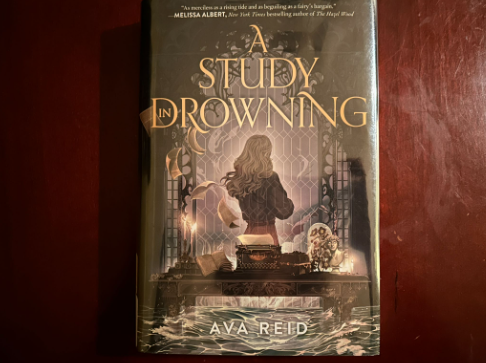Too often today, fantasy novels are reduced to cliched plots and lazily written archetypal characters. Yet in the hauntingly atmospheric world of “A Study in Drowning,” author Ava Reid expertly examines the impact of workplace sexism, abuse and emotional manipulation on young people on the fringes of society. Reid’s lush, evocative language and slowly unfurling plot all work to construct a novel that is at once a familiar mystery and a complex social critique.
“A Study in Drowning” follows Effy Sayre, a young architectural student who longed to attend a prestigious literature school but was rejected because women were not allowed in. To cope with childhood trauma and everyday slights at her university, Effy idolizes an in-world book, Angharad. The myth describes a mortal girl who, after falling in love with the Fairy King, ultimately destroys him.
It’s this story that provides Effy comfort in her recurring visions of the Fairy King and in her alienation at the university. So when Effy is summoned to redesign the crumbling-over-the-sea estate of Angharad’s late author, she doesn’t hesitate.
Once there, however, Effy meets a literature student brought to the author’s estate for a different reason: to expose Angharad’s author as fake. Although initially opposed, Effy’s further investigations lead her closer to the truth about the author–about Angharad itself, and perhaps about her own life.
In telling Effy’s story, Reid’s greatest strength is her word choice. Her prose is not merely a vehicle to carry her story through its major plot points. Instead, it’s a catalyst for the complex themes woven throughout the narrative.
In her repetition of phrases associated with the sea, Reid unites the sea-side environment of the author’s estate, the unique characterization of the sea mentioned in Angharad and Effy’s myth-related backstory.
In doing so, the reality the reader experiences in the novel is forever blurred. Effy’s disorientation, therefore, becomes the audience’s as thematic and concrete realities collide.
Through these parallels, Reid fleshes out the theme of what society perceives as sanity, especially concerning the stories of women.
Yet “A Study in Drowning” is more than a study in atmosphere. Reid strongly characterizes Effy and the supporting cast in a familiar but not simplified way. Surface-level appearances are mined by Reid to expose each character’s insecurities and rawest selves.
And despite the use of the oft-cliched trope of academic rivals-to-lovers, Reid refuses to grant Effy an easy happily-ever-after. Instead, Effy’s romantic experience is messy, stagnated by personal issues and more an exploration of Effy’s character than an attempt to please the audience.
This sensitive unraveling of Effy’s character is mirrored in Reid’s carefully timed plot reveals. Each new piece of information piques the reader’s interest while adding to the growing tension of the mystery. The initially slower-paced plot works in Reid’s favor: readers are allowed time to process the reveals and emotionally connect with the characters.
And as the plot gains momentum, so too does the symbolism; dense, dream-like passages are intertwined with each twist and turn of the mystery, moving all the right pieces into place for a show-stopping climax.
Yet, disappointingly, it’s here Reid fails to unite her themes with the resolution of the mystery successfully.
Although symbolic, the climax is short and the external turmoil is easily resolved. The twist is almost too good to be true–it features an unnecessary backstory where the novel’s themes fail to be reinvented, instead presented as a regurgitation of previous plot points. The symbolism begins to look like heavy-handed foreshadowing in hindsight, most likely not Reid’s intention for such a complex novel.
What’s clear is this: Reid chose to prioritize thematic significance at the expense of an impactful answer to the mystery.
And this failure of climactic structure compromises the theme itself. How much more powerful would the theme be if the climax was just as structurally thrilling? Reid seemed to understand the close relationship between plot, characterization and theme earlier in the novel but fails to successfully execute this knowledge when it matters most.
Loose ends are neatly tied up; the audience is left wanting more. It’s because of this–despite Reid’s chilling prose, masterful characterization and deft thematic development–”A Study in Drowning” is a 3 star read. It’s unfortunate that such a beautiful, promising novel ended in a missed opportunity.












![In this documentary, you will learn how violins are made. All music is in the public domain:
Music Produced by Deutsche Grammophon, Medici TV, Heifetz Institute, and Queen Elisabeth competition
Paganini, Caprice No. 24 [Song recorded by Jasha Heifetz]. Heifetz Institute. (Original work published 1817)
Paganini, Caprice No. 24 [Song recorded by Jasha Heifetz]. Heifetz Institute. (Original work published 1817)
Bartok, Sonata No.1 for Solo Violin [Song recorded by Kevin Zhu]. Queen Elizabeth Competition. (Original work published 1944)
Paganini, Violin Concerto no. 1 [Song recorded by Philippe Hirshhorn]. Queen Elizabeth Competition. (Original work published 1819-1825)](https://southblueprint.com/wp-content/uploads/2025/05/Screenshot-2025-05-07-122429-1200x668.png)






